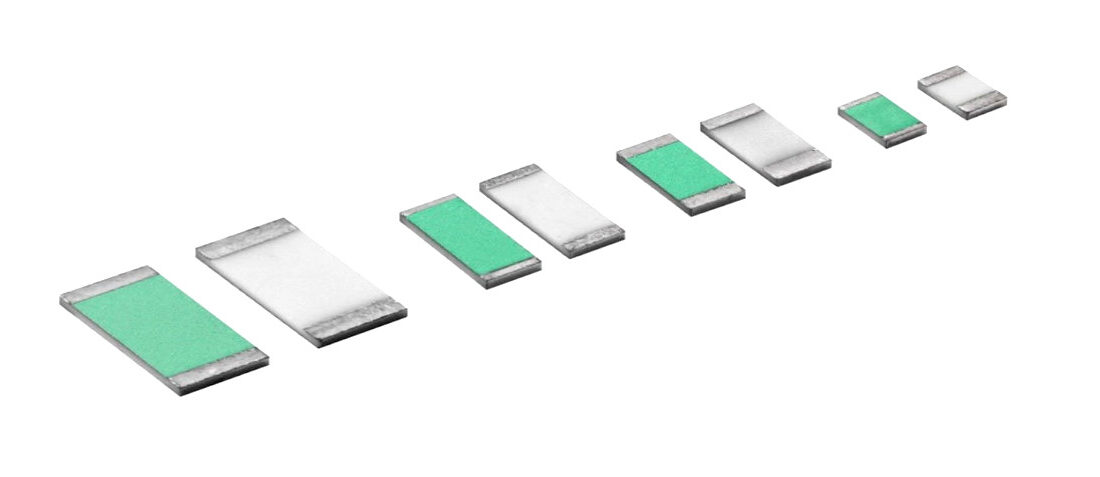
TCR value in high-precision resistor selection
- Posted by doEEEt Media Group
- On July 29, 2020
- 0
Understanding resistor temperature coefficient of resistance in applications where high-precision and temperature stability are required.
Temperature coefficient of resistance (TCR) is the calculation of a relative change in resistance per degree of temperature change. It is measured in ppm/°C (1ppm = 0.0001%) and is defined as: TCR = (R2- R1)/ R1(T2- T1). For high-precision resistors, TCR is typically expressed in parts per million (ppm) per degrees Celsius, with reference to normal room temperature, typically +25°C.
Despite the importance of this specification, individual resistor manufacturers use different methods for calculating TCR, which may not provide enough information to enable an end user to accurately predict the influence of temperature changes on resistance value. Such published TCR variances therefore have the potential to create measurement uncertainty, in applications where high-precision resistor performance and temperature stability are absolute requirements.
In high-precision devices, such as the Bulk Metal Foil resistors manufactured by the Vishay Foil Resistors brand of Vishay Precision Group (VPG), published TCR specifications include nominal typical curves, normally from -55°C to +125°C, which define nominal “cold” (-55°C to +25°C) and “hot” (+25°C to +125°C) chord slopes. Product datasheets typically specify the maximum spread for each slope (e.g., ±0.2ppm/°C and ±1.8ppm/°°C).
The relationship between resistor performance and temperature
Temperature affects resistor component operation and resistor behavior within the installation environment. As electrical current flows through a resistor, it generates heat: the Joule effect. The resulting thermal response induces relative mechanical changes and stresses within the resistor. Stresses caused by differential thermal expansions can vary by resistor materials of construction and other factors. Ambient temperatures within the installation environment can generate heat, affecting resistor performance.
An optimal resistor design minimizes susceptibility to external and internal stresses during different usages and power loads, without sacrificing performance and reliability. VPG Bulk Metal Foil technology creates a precise thermo-mechanical balance between generated heat, materials of construction, and associated manufacturing processes. Careful design can compensate for the effects of heat and stress during operation, increasing performance stability.
For example, VPG designs ultra-high precision resistors incorporating a Bulk Metal Foil element, by first bonding a proprietary cold-rolled foil material onto a ceramic substance. That is photoetched into a resistive pattern, without introducing mechanical stresses onto the material. Then the resistors are laser-adjusted to a specified resistance value and tolerance. Because the resistive material is neither drawn, wound, nor mechanically stressed during manufacturing, the Bulk Metal Foil maintains intended design characteristics and full performance reliability, including TCR.
Other resistor manufacturing methods, such as wire winding, thin-film sputtering, or thick-film glazing, can introduce mechanical stresses and have greater potential for thermo-mechanical imbalance. When a resistor is operating higher than rated temperatures, it can fail to function or incur damage that directly compromises accuracy. Resistor over-temperature conditions throughout an extended timeframe may permanently change individual resistance values, leading to a complete circuit malfunction. Users should pay close attention to rated temperature specifications to ensure that a resistor is operating according to published specifications. By adhering closely to these values, the user can be assured of continued resistor reliability, regardless of manufacturing process.
Interpreting indicators
Despite differences in designs and manufacturing processes, TCR remains one of the most commonly accepted resistor performance stability indicators. TCR is imperative for predicting resistor sensitivity to ambient temperature variations, as well as anticipated component behavior at low- and high-operating temperatures.
Bulk Metal Foil resistor TCR considers extreme theoretical conditions within individual specification limits. In contrast with technologies such as thin film, manufacturers can typically present TCR in a relatively narrow temperature range, with less emphasis on extreme temperature effects.
TCR may be further defined as a resistance change between two temperatures, divided by the temperature difference (chord slope), or TCR = (ΔR/R)/ΔT. It is common practice to define cold chord slope from -55°C to +25°C, and hot chord slope from +25°C to +125°C (in this case ΔThot = +125°C – +25°C = +100°C).
However, any other temperature interval (ΔT) may be defined. To define the rate of change in resistance at any temperature on the curve, TCR is calculated mathematically when ΔT becomes infinitely small(ΔT→0): TCR(ΔT→0) = (dR/R)/ dT
The change in resistance vs. temperature in NiCr resistors is nonlinear, normally following a parabola. Mathematically, this function can be described by:
Y = aX2 + bX + c where: Y =ΔR/R (normally expressed in ppm) X = T (temperature in °C)
In this case, for any temperature T, Y will express the value of the change in resistance ΔR/R, normally in ppm, from the nominal value at +25°C. In other words, for the function Y, this will be expressed by the derivative function Y’. This function defines the slope (TCR) of a line tangent to the parabola and indicates how TCR is changing. For the above parabola function: Y’= 2aX + b (Y’ is expressed in ppm/°C).
For simplicity, one can also use the fact that a chord slope equals the tangent midpoint value of the relevant temperature range. For example, the value of the hot slope (+25°C to +125°C) equals the tangent value (Y’) at the midpoint, T = +75°C.
Thin-film resistor manufacturers often target best hot slope, while keeping cold slope within the specified limit. A study conducted to compare and analyze VPG Bulk Metal Foil and thin-film precision resistor TCR, using the change rate calculation method, has shown that a change in resistance due to temperature can be significantly larger than specified TCR limits. This comparison is based on tests conducted on two groups of different precision thin-film NiCr resistors from different manufacturers, each specifying a TCR of 5ppm/°C.
Results of this study demonstrated that the maximum change in resistance (TCR) due to temperature changes across the temperature axis from -55°C to +125°C will vary in Bulk Metal Foil resistors from -2.17ppm/°C to +2.2ppm/°C, for a total of less than 4.37ppm/°C. For the same temperature range, the TCR of the thin-film resistor sample from manufacturer A varied from -3.6ppm/°C to +7.2ppm/°C, for a total of nearly 11ppm/°C; and from manufacturer B, from -9.1ppm/°C to +4.99ppm/°C, for a total of 14ppm/°C.
So, precision thin-film resistors may exhibit a TCR that is much higher than specified limits on the manufacturer’s datasheet.
Bulk Metal Foil resistor TCR is achieved by matching two opposing effects of the inherent increase in resistance due to temperature increase vs. the compression-related decrease in resistance caused by the temperature increase. The two effects occur simultaneously, resulting in an unusually low, predictable, and repeatable TCR specification. As a result, Bulk Metal Foil resistors achieve intrinsic maximum stability and near-zero TCR, a specification not reliant on screening or other means for achieving uniform high-precision resistor performance and temperature stability. VPG employs this stringent TCR calculation method to ensure high-precision resistor reliability across full resistance values and operating temperature ranges.The true value of TCR.
For engineers selecting high-precision resistors, TCR specifications can help them to better predict reversible shifts in component resistance from an ohmic value within the application, under intended operating temperatures and within the installation environment. As TCR calculation methods can vary by manufacturer, manufacturing process, materials of construction, and other aspects, it is important for users to understand any nuances in the chosen method, to better understand TCR data as a component reliability metric. VPG methods for calculating TCR follow strict protocols to help engineers to be confident in the long-term reliability of components within demanding applications.
source: Todays Medical Developments article
March 27, 2018
Molly Chamberlin for Vishay Precision Group Inc.
featured image: The Vishay Foil Resistors Model FRSM wrap-out chip resistor with low TCR, incorporating Z-Foil technology.
- Managing EEE components for LEO and lower cost space missions - December 17, 2024
- Filtering Characteristics of Parallel-Connected Fixed Capacitors in LCC-HVDC - November 21, 2024
- ALTER SPACE TEST CENTER: testing approaches for New Space - September 30, 2024


0 comments on TCR value in high-precision resistor selection